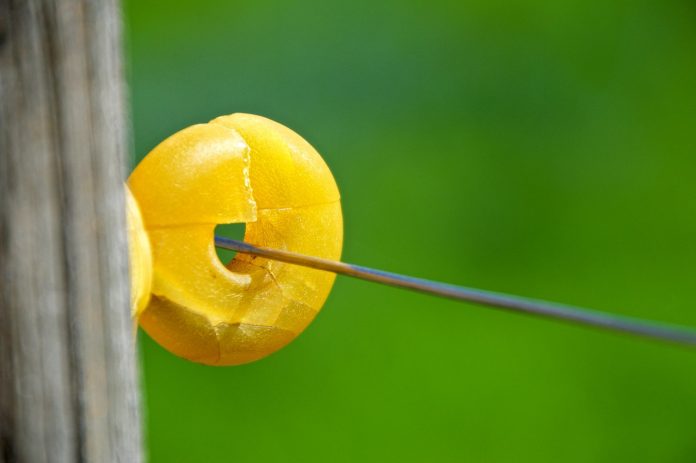Electric fencing can be a great tool to help manage the use of your pastures or it can be a source of constant aggravation. A fence is only as good as its weakest component and taking shortcuts or trying to save money may cost hours of time troubleshooting problems.
I remember watching sheep running one by one and diving through the electric high tensile fence wires because they thought the grass was greener on the other side. The real aggravation came upon learning the fence had enough voltage to drop a man to his knees.
Let’s take a look at a couple of the main components found in electric fencing systems and how we can get the most out of our investment.
Energizer
The energizer will determine the maximum ability of the fence to maintain animals in the correct location. You will notice I said maximum because several factors can reduce the ability of the energizer to do its job.
Location of the fence may determine the power source options for your energizer. Generally, an energizer that can plug into an outlet will be the most economical. These can typically operate for a couple dollars a month or less.
But the location of the fence may prevent the use of AC power. Options for battery-powered and solar-charged energizers keep improving and may be your best option in some situations.
Impedance is a measure of opposition to electric current. A low impedance energizer has short duration pulses, which allow more power to pass through vegetation. A high impedance energizer has a long pulse duration.
Most of the high impedance “weed burner” energizers are no longer on the market due to safety issues. They have been known to start fires.
Solid-state energizers have a medium pulse duration.
If you are working with poly fencing materials, low impedance energizers are best for that use. The longer duration of pulses with solid state and high impedance energizers can damage conductor wires in the poly materials and shorten their life.
Joules is a term that is associated with power of fence energizers. It is a measure of the strength of the energizer to push voltage through the fence. There are differences in how these are reported as either output joules or stored joules.
When comparing energizers, the output joules is the important part and is approximately 70% of the stored joules. Typically, as joules increase so does the length of fence that can be charged.
Comparing output joules between two similar low impedance energizers is likely the best way to compare apples to apples with different fence energizers.
A rule of thumb, according to grazing consultant Dr. Jim Gerrish, is one joule of energizer output will charge 1 mile of fence regardless of the number of wires.
Some energizers come with ratings for the number of miles of fence they can charge. These ratings are based on best conditions and may vary between manufacturers. Be careful when looking at these numbers between brands.
Grounding
Poor grounding is one of the most common faults in electric fencing systems. If the ground is not completed correctly, the energizer cannot operate at is maximum potential.
A rule of thumb is three feet of ground rod for each output joule of energy from the energizer.
An eight-Joule output energizer would need 24 feet of ground rod. This could be accomplished by driving three ground rods that are each eight feet long into the ground at least 10 feet apart and attaching them.
Ground rods of 5/8-inch galvanized steel or 3/4-inch galvanized pipe are better than copper for grounding electric fence due to metal compatibility with the galvanized connectors, which typically used with fencing.
Placing the rods along the eaves of a building where the soil stays moist can help with grounding. In dry stony soil, additional ground rods may be needed.
Two different grounding systems can be used. The first involves driving the ground rods and connecting them directly to the energizer. The fence is connected to the positive terminal and the circuit is complete.
The second type can be used with high tensile wire fencing systems. Alternating fence wires are insulated and connected to the positive output terminal on the energizer. The uninsulated wires are then connected to each other, the ground terminal on the energizer, and the ground rods.
Additional ground rods can be attached to the uninsulated wires at 1,500-foot intervals along the fence.
This second method can be useful with sheep and goats and has advantages in areas where the soil is dry or in frozen ground where grounding is poor.
Contact with the ground wire and the hot wire will provide a shock even if their feet are off the ground such as when they run and dive through the fence! Maybe I should have tried this method.
The disadvantage with this system is the possibility of shorting if a limb falls on the fence.
Other considerations
Connections of wires can also be points of weakness. Using proper connectors can be more expensive than simply wrapping wires around each other, but the poor contact from wrapped wires can lead to arcing, which can burn off wires.
Underground jumper wires need to be made of materials designed for that purpose but even then, they only last so long.
Do not forget to inspect the fences for broken insulators, heavy weed loads, or damage from wildlife. It is always better to find the problem before the livestock find it.














Electric dog fences/bark collars burn your dog. I have pictures of my brother’s dog with a severe burn on his neck. I was going to install a invisible fence this week, however after seeing what it did to his dog, it’s going back to where I bought it. I just wish I could show the pic of the dogs neck along with the comment.